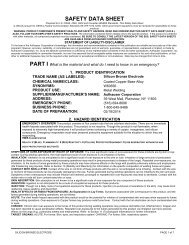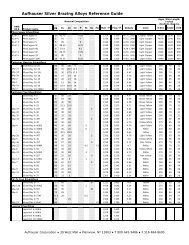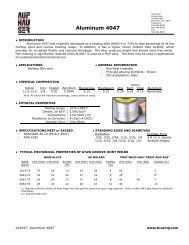MSDS - Aufhauser Corporation
MSDS - Aufhauser Corporation
MSDS - Aufhauser Corporation
Create successful ePaper yourself
Turn your PDF publications into a flip-book with our unique Google optimized e-Paper software.
ADDITIONAL CANADIAN REGULATIONS:<br />
CANADIAN DSL/NDSL INVENTORY STATUS: The components of these products are on the DSL Inventory.<br />
OTHER CANADIAN REGULATIONS: Not applicable.<br />
CANADIAN ENVIRONMENTAL PROTECTION ACT (CEPA) PRIORITIES SUBSTANCES LISTS: Cryolite (as an Inorganic<br />
Fluoride) is classified as Toxic on the CEPA First Priorities Substance Lists.<br />
CANADIAN WHMIS SYMBOLS: Not applicable.<br />
<br />
16. OTHER INFORMATION<br />
PREPARED BY:<br />
<strong>Aufhauser</strong> <strong>Corporation</strong><br />
39 West Mall<br />
Plainview, NY 11803<br />
(516) 694-8696<br />
DATE OF PRINTING: August 25, 2006<br />
This Safety Data Sheet is offered pursuant to OSHA’s Hazard Communication Standard (29 CFR 1910.1200). Other government<br />
regulations must be reviewed for applicability to these products. The information contained herein relates only to the specific<br />
product. If the product is combined with other materials, all component properties must be considered. To the best of the <strong>Aufhauser</strong><br />
<strong>Corporation</strong>’s knowledge, the information and recommendations contained in this publication are reliable and accurate as of the<br />
date of issue. However, accuracy, suitability, or completeness are not guaranteed, and no warranty, guarantee, or representation,<br />
expressed or implied, is made by <strong>Aufhauser</strong> <strong>Corporation</strong> as to the absolute correctness or sufficiency of any representation<br />
contained in this and other publications; <strong>Aufhauser</strong> <strong>Corporation</strong> assumes no responsibility in connection therewith; nor can it be<br />
assumed that all acceptable safety measures may not be required under particular or exceptional conditions or circumstances. Data<br />
may be changed from time to time. Be sure to consult the latest edition.<br />
DEFINITIONS OF TERMS<br />
A large number of abbreviations and acronyms appear on a SDS. Some of these, which are commonly used, include the following:<br />
CAS #: This is the Chemical Abstract Service Number which uniquely identifies each constituent.<br />
EXPOSURE LIMITS IN AIR:<br />
FLAMMABILITY LIMITS IN AIR:<br />
ACGIH - American Conference of Governmental Industrial Much of the information related to fire and explosion is derived<br />
Hygienists, a professional association which establishes<br />
from the National Fire Protection Association (NFPA). Flash<br />
exposure limits. TLV - Threshold Limit Value - an airborne Point – Minimum temperature at which a liquid gives off<br />
concentration of a substance which represents conditions under sufficient vapors to form an ignitable mixture with air.<br />
which it is generally believed that nearly all workers may be Autoignition Temperature: The minimum temperature required to<br />
repeatedly exposed without adverse effect. The duration must initiate combustion in air with no other source of ignition. LEL -<br />
be considered, including the 8-hour Time Weighted Average the lowest percent of vapor in air, by volume, that will explode or<br />
(TWA), the 15-minute Short Term Exposure Limit, and the ignite in the presence of an ignition source. UEL - the highest<br />
instantaneous Ceiling Level (C). Skin absorption effects must percent of vapor in air, by volume, that will explode or ignite in<br />
also be considered.<br />
the presence of an ignition source.<br />
OSHA - U.S. Occupational Safety and Health Administration. TOXICOLOGICAL INFORMATION:<br />
PEL - Permissible Exposure Limit - This exposure value means Human and Animal Toxicology: Possible health hazards as<br />
exactly the same as a TLV, except that it is enforceable by derived from human data, animal studies, or from the results of<br />
OSHA. The OSHA Permissible Exposure Limits are based in the studies with similar compounds are presented. Definitions of<br />
1989 PELs and the June, 1993 Air Contaminants Rule (Federal some terms used in this section are: LD50 - Lethal Dose (solids<br />
Register: 58: 35338-35351 and 58: 40191). Both the current & liquids) which kills 50% of the exposed animals; LC50 - Lethal<br />
PELs and the vacated PELs are indicated. The phrase,<br />
Concentration (gases) which kills 50% of the exposed animals;<br />
“Vacated 1989 PEL,” is placed next to the PEL which was ppm concentration expressed in parts of material per million<br />
vacated by Court Order. IDLH - Immediately Dangerous to Life parts of air or water; mg/m3 concentration expressed in weight<br />
and Health – This level represents a concentration from which of substance per volume of air; mg/kg quantity of material, by<br />
one can escape within 30- minutes without suffering escapepreventing<br />
or permanent injury. The DFG - MAK is the Republic weight in kg. Other measures of toxicity include TDLo, the<br />
weight, administered to a test subject, based on their body<br />
of Germany’s Maximum Exposure Level, similar to the U.S. lowest dose to cause a symptom and TCLo the lowest<br />
PEL. NIOSH is the National Institute of Occupational Safety and concentration to cause a symptom; TDo, LDLo, and LDo, or<br />
Health, which is the research arm of the U.S. Occupational TC, TCo, LCLo, and LCo, the lowest dose (or concentration) to<br />
Safety and Health Administration (OSHA). NIOSH issues cause lethal or toxic effects. Cancer Information: The sources<br />
exposure guidelines called Recommended Exposure Levels are: IARC - the International Agency for Research on Cancer;<br />
(RELs). When no exposure guidelines are established, an entry NTP – the National Toxicology Program, RTECS - the Registry<br />
of NE is made for reference.<br />
of Toxic Effects of Chemical Substances, OSHA and<br />
HAZARD RATINGS:<br />
CAL/OSHA. IARC and NTP rate chemicals on a scale of<br />
HAZARDOUS MATERIALS IDENTIFICATION SYSTEM: decreasing potential to cause human cancer with rankings from<br />
Health Hazard: 0 (minimal acute or chronic exposure hazard); 1 1 to 4. Subrankings (2A, 2B, etc.) are also used. Other<br />
(slight acute or chronic exposure hazard); 2 (moderate acute or Information: BEI - ACGIH Biological Exposure Indices,<br />
significant chronic exposure hazard); 3 (severe acute exposure represent the levels of determinants which are most likely to be<br />
hazard; onetime overexposure can result in permanent injury observed in specimens collected from a healthy worker who has<br />
and may be fatal); 4 (extreme acute exposure hazard; onetime been exposed to chemicals to the same extent as a worker with<br />
overexposure can be fatal). Flammability Hazard: 0 (minimal inhalation exposure to the TLV. Ecological Information: EC is<br />
hazard); 1 (materials that require substantial pre-heating before the effect concentration in water. BCF = Bioconcentration<br />
ALUMINUM BRONZE ELECTRODE PAGE 7 of 8






